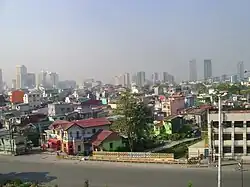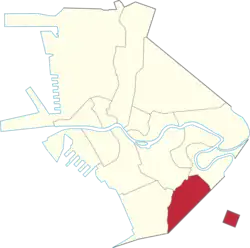San Andres
San Andres Bukid | |
|---|---|
District of Manila | |
 | |
 | |
| Country | Philippines |
| Region | National Capital Region |
| City | Manila |
| Congressional districts | Part of the 5th district of Manila |
| Barangays | 65 |
| Area | |
| • Total | 1.6802 km2 (0.6487 sq mi) |
| Population (2020) | |
| • Total | 133,727 |
| • Density | 80,000/km2 (210,000/sq mi) |
San Andres (also San Andres Bukid, bukid being the Tagalog for "farm" or "[rice] field") is a district of Manila, Philippines. San Andres shares the Estero Tripa de Gallina as its western and northern border with the districts of Malate and Paco, respectively and Pedro Gil and Tejeron streets to the east with the district of Santa Ana. It borders the cities of Pasay and Makati in the south. The area is under the jurisdiction of the Fifth Congressional District of Manila, and includes the Manila South Cemetery, an exclave of the city surrounded by land administered by Makati.
Profile
Although San Andres has only a small land area, it is the most densely populated district in Manila, as of 2015, surpassing even Tondo. San Andres is divided into its eastern and western sectors by the Osmeña Highway. Mostly residential, San Andres also has some sections classified as commercial.
The majority of the district's population live just above the poverty line, mostly composed of post-World War II settlers from various provinces while the original inhabitants were middle or lower-class migrant families who had formerly settled in Tondo but found the rough working-class lifestyle less suitable for raising children. The influx of settlers into the district was unregulated, resulting in a lack of urban planning as evidenced by irregular buildings, narrow roadways, and large blocks of houses accessible only through meter-wide alleyways.
Barangays
San Andres has 65 barangays.
| Zones | Barangays |
|---|---|
| 81 | 745, 746, 747, 748, 749, 750, 751, 752, 753, and 754 |
| 82 | 755, 756, 757, 758, 759, 760, 761, and 762 |
| 83 | 763, 764, 765, 766, 767, 768, and 769 |
| 84 | 770, 771, 772, 773, 774, and 775 |
| 85 | 776, 777, 778, 779, 780, 781, 782, and 783 |
| 86 | 784, 785, 786, 787, 788, 789, 790, 791, 792, and 793 |
| 87 | 794, 795, 796, 797, 798, 799, 800, 801, 802, 803, 804, 805, 806, and 807 |
| 88 | 808 and 818-A |
| Zone/Barangay | Land area (km²) | Population (2020 census) |
| Zone 81 | ||
| Barangay 745 | 0.01368 km² | 2,015 |
| Barangay 746 | 0.03431 km² | 1,663 |
| Barangay 747 | 0.01162 km² | 369 |
| Barangay 748 | 0.02862 km² | 812 |
| Barangay 749 | 0.01158 km² | 616 |
| Barangay 750 | 0.02622 km² | 1,107 |
| Barangay 751 | 0.02500 km² | 1,541 |
| Barangay 752 | 0.01707 km² | 763 |
| Barangay 753 | 0.02440 km² | 2,380 |
| Barangay 754 | 0.01321 km² | 2,584 |
| Zone 82 | ||
| Barangay 755 | 0.03368 km² | 1,372 |
| Barangay 756 | 0.02718 km² | 721 |
| Barangay 757 | 0.01371 km² | 477 |
| Barangay 758 | 0.01919 km² | 399 |
| Barangay 759 | 0.02807 km² | 787 |
| Barangay 760 | 0.02862 km² | 1,041 |
| Barangay 761 | 0.02923 km² | 1,062 |
| Barangay 762 | 0.02659 km² | 365 |
| Zone 83 | ||
| Barangay 763 | 0.02910 km² | 1,779 |
| Barangay 764 | 0.04799 km² | 2,022 |
| Barangay 765 | 0.02925 km² | 2,075 |
| Barangay 766 | 0.02168 km² | 3,101 |
| Barangay 767 | 0.04205 km² | 5,429 |
| Barangay 768 | 0.02618 km² | 1,147 |
| Barangay 769 | 0.03396 km² | 1,997 |
| Zone 84 | ||
| Barangay 770 | 0.05491 km² | 9,651 |
| Barangay 771 | 0.02879 km² | 1,813 |
| Barangay 772 | 0.03136 km² | 2,426 |
| Barangay 773 | 0.02712 km² | 2,748 |
| Barangay 774 | 0.01882 km² | 2,878 |
| Barangay 775 | 0.04849 km² | 12,084 |
| Zone 85 | ||
| Barangay 776 | 0.03147 km² | 4,592 |
| Barangay 777 | 0.02803 km² | 3,011 |
| Barangay 778 | 0.01567 km² | 1,848 |
| Barangay 779 | 0.03686 km² | 4,444 |
| Barangay 780 | 0.03174 km² | 2,316 |
| Barangay 781 | 0.03282 km² | 4,275 |
| Barangay 782 | 0.02517 km² | 1,483 |
| Barangay 783 | 0.02714 km² | 2,145 |
| Zone 86 | ||
| Barangay 784 | 0.02519 km² | 3,386 |
| Barangay 785 | 0.01440 km² | 932 |
| Barangay 786 | 0.02850 km² | 1,439 |
| Barangay 787 | 0.02013 km² | 3,622 |
| Barangay 788 | 0.01417 km² | 969 |
| Barangay 789 | 0.01974 km² | 1,620 |
| Barangay 790 | 0.05244 km² | 1,741 |
| Barangay 791 | 0.02746 km² | 2,029 |
| Barangay 792 | 0.03035 km² | 2,559 |
| Barangay 793 | 0.02300 km² | 1,722 |
| Zone 87 | ||
| Barangay 794 | 0.01193 km² | 710 |
| Barangay 795 | 0.006150 km² | 1,157 |
| Barangay 796 | 0.01082 km² | 631 |
| Barangay 797 | 0.008080 km² | 244 |
| Barangay 798 | 0.02783 km² | 1,562 |
| Barangay 799 | 0.01618 km² | 544 |
| Barangay 800 | 0.01878 km² | 1,558 |
| Barangay 801 | 0.02077 km² | 614 |
| Barangay 802 | 0.02825 km² | 1,787 |
| Barangay 803 | 0.04550 km² | 1,705 |
| Barangay 804 | 0.02363 km² | 1,251 |
| Barangay 805 | 0.01954 km² | 1,237 |
| Barangay 806 | 0.02879 km² | 1,603 |
| Barangay 807 | 0.03136 km² | 2,010 |
| Zone 88 | ||
| Barangay 808 | 0.02769 km² | 2,183 |
| Barangay 818-A | 0.008350 km² | 1,564 |
History
What is now San Andres Bukid was carved from the pre-World War II district of Singalong as well as parts of Santa Ana, Malate, and Paco districts.[1] Singalong district is largely absorbed into San Andres and is commemorated by a namesake street that runs perpendicular to Quirino Avenue and parallel to Taft Avenue. The street lies west of what is now the western section of San Andres. Elderly residents of Singalong believe that the area's name was derived from a Tagalog word for a cup fashioned from bamboo.
In the Spanish colonial era, Spaniards awarded the area to members of the Capuchin missionaries who thereafter converted the native population to Catholicism. In the aftermath of the Second World War, the southern section of Manila was devastated as with most of the city. San Andres was then mostly open space, and it was repopulated by migrants from nearby provinces and the Visayas.
San Andres Street
 San Andres Street looking north. | |
| Former name(s) | none |
|---|---|
| Length | 2 km (1.2 mi) |
| Location | Manila |
| North end | Augusto Francisco Street in San Andres |
| Major junctions |
|
| South end | |
San Andres Street is a road in the city of Manila. It starts from Augusto Francisco Street in San Andres. It traverses the neighborhoods of Rubi, Coral, and Nakar. It crosses ![]() N145 (Osmeña Highway).
N145 (Osmeña Highway).
It was bisected by Taft Avenue in front of Quirino Avenue LRT Station. It continues at the intersection of Quirino Avenue and traverses the Malate streets of Pilar Hidalgo Lim, Guerrero, Maria Orosa Avenue, Adriatico Street, Mabini, and Del Pilar Street. It terminates at ![]() N120 (Roxas Boulevard) in Malate.
N120 (Roxas Boulevard) in Malate.
Intersections
The entire route is located in Manila.
| km | mi | Destinations | Notes | ||
|---|---|---|---|---|---|
| Augusto Francisco Street | Northern terminus. | ||||
| Rubi Street | |||||
| Nakar Street | Shift to one-way northbound. | ||||
| Traffic light intersection. Shift to two-way road. | |||||
| G. Del Pilar Street | Northbound access only. | ||||
| Taal Street | |||||
| Anak Bayan Street | |||||
| A. Linao Street | Shift to one-way northbound. | ||||
| Singalong Street | |||||
| Benitez Street | |||||
| Leon Guinto Street | |||||
| Bisected by Taft Avenue. | |||||
| P. Hidalgo Lim Street | |||||
| Guerrero Street | |||||
| Leveriza Street | |||||
| Maria Orosa Avenue | Shift to two-way road. | ||||
| Adriatico Street | Traffic light intersection. | ||||
| Madre Ignacia Street | |||||
| Mabini Street | Traffic light intersection. | ||||
| Del Pilar Street | Traffic light intersection. | ||||
| Southern terminus. | |||||
| 1.000 mi = 1.609 km; 1.000 km = 0.621 mi | |||||
References
- "By Sword and Fire: The Destruction of Manila in World War II, 3 February-3 March 1945" by Alphonso J. Aluit (1994) Bookmark, Inc. © 1994 National Commission for Culture and the Arts ISBN 971-569-162-5
- San Andres Manila Volunteer Fire Brigade Inc., History by Charles Chua, Callsign San Andres 1, Presently President and Brigade Fire Marshall
